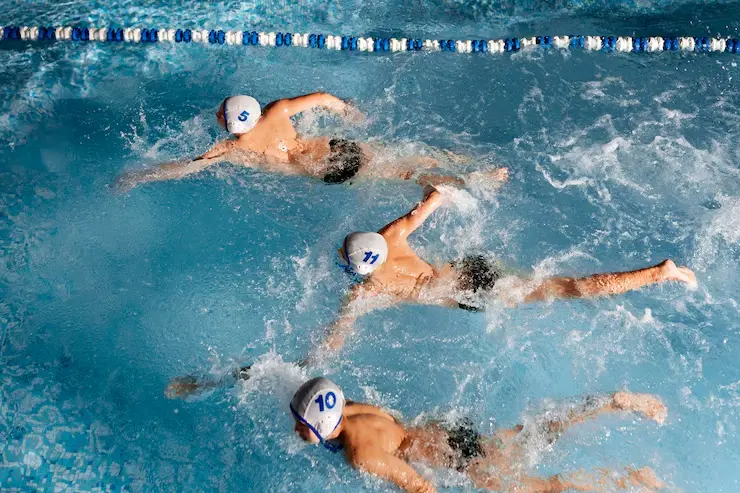“Swim around scare some people.”
It’s a bold phrase — one that hints at more than just freestyle or backstroke. It’s about doing something so wild, so daring, so unexpected, that people stop and stare. Some with awe. Some with fear. But almost always, with respect.
In the world of swimming, this isn’t just about technique or medals. It’s about pushing boundaries, challenging yourself, and doing the kind of swim that makes people say, “Wait, you did what?!”
This article dives deep into why swimmers chase fear, what it means to “swim around scare some people,” and how you can prepare for swims that both challenge and transform you.
1. Why Do People Crave Fear in Swimming?
Swimming is often seen as calming — peaceful laps in a pool, floating under the sun. But some swimmers aren’t after serenity. They crave discomfort, challenge, and even fear.
Why? Because fear is a sign you’re growing.
For some, fear keeps them away from the water. For others, it draws them in. They want to swim around scare some people — not out of arrogance, but because conquering the water means conquering something inside themselves.
Whether it’s fear of deep water, fear of open ocean currents, or the fear of failing in public, extreme swimmers chase it. And then they crush it.2. The Psychology Behind Thrill-Seeking Swims
Swimming is more mental than most think. Beyond technique lies something deeper — mindset.
Psychologists call it sensation-seeking or discomfort tolerance. It’s the idea that pushing yourself beyond your comfort zone — even to the point of fear — rewires your brain.
Adrenaline floods the system.
Focus sharpens.
Limits shift.
That’s why people swim through ice, cross the English Channel, or dive into pitch-black waters at night. They’re not just swimming — they’re proving something. To themselves. To others. Sometimes, to the world.
When someone decides to swim around scare some people, they’re choosing self-reinvention. They’re choosing to get uncomfortable — and that’s where the transformation happens.
3. Top Extreme Swims That Could Terrify (and Inspire) You
Ready to be impressed — maybe even a little scared?
Here are some of the world’s most fear-inducing swims that redefine what’s humanly possible:
1. The English Channel (UK)
21 miles of cold, jellyfish-filled water.
Strong currents and tankers passing nearby.
Swimmers face exhaustion, hypothermia, and seasickness.
Sophie Etheridge swam this in 29 hours using only her arms due to chronic disability. That’s not just tough — that’s legendary.
2. Ice Swimming (Various Locations)
Water below 5°C.
No wetsuits.
Danger of cold shock and unconsciousness within minutes.
3. North Channel (Ireland to Scotland)
Even colder than the English Channel.
Filled with jellyfish and unpredictable weather.
Only elite swimmers attempt it.
4. Catalina Channel (California, USA)
Dark waters, marine life (hello, sharks), and long distances.
Done mostly at night for calm seas.
5. Strait of Gibraltar
You swim from Europe to Africa.
Strong cross-currents and heavy marine traffic.
Each of these swims earns a double take. They scare some people — and that’s the point.
4. How Swimming Can Push Mental and Physical Boundaries
Swimming isn’t just a physical sport — it’s a war with the mind.
When you’re in open water, surrounded by endless blue, every stroke becomes a negotiation between your brain and your body. Thoughts like:
“Can I finish this?”
“What if something goes wrong?”
“What if I look ridiculous or fail?”
That’s when people grow. That’s when swimming becomes transformation.
By choosing to swim around scare some people, you’re not showing off. You’re showing up. You’re doing the thing most wouldn’t even try. And in doing so, you start changing how you see your limits — and how others see theirs too.
5. Real Stories: People Who Faced Their Fears in the Water
Sophie Etheridge
Diagnosed with Fibromyalgia and Complex Regional Pain Syndrome, she’s wheelchair-bound on land — but not in water.
Despite pain that made touching water difficult, she swam the English Channel using only her arms, becoming one of the most inspiring adaptive athletes in open water history.
Her next goal? UltraSwim 33.3 in Montenegro, a multi-day, international swim series that includes:
Point-to-point swimming
Travel challenges
Swimming through pain
She didn’t just swim. She scared people — and inspired thousands more.
Anonymous Corporate Swimmer
After nearly drowning as a child, one man avoided swimming for decades. A corporate swimrun challenge changed everything. He faced:
Panic attacks
Self-doubt
Physical exhaustion
He learned to freestyle as an adult, trained alone, took lessons, and eventually completed a swimrun. His message?
It’s never too late to become someone who scares even their past self.
6. Tips for Preparing for a Swim That Scares You (In a Good Way)
Want to push your boundaries? Here’s how to do it safely and smartly:
1. Train Consistently
Start slow. Build endurance. Mix open water and pool training.
2. ace the Mental Game
Practice mindfulness or meditation.
Visualize success.
Talk to other swimmers who’ve done scary swims.
3. Get the Right Support
Swim coaches
Swim buddies
Safety kayakers or crews
4. Prepare for Logistics
If you’re a wheelchair user or have specific needs, communicate early. Organizers are often more supportive than you’d expect.
5. Start Small but Bold
Your “scary” swim might be:
Swimming across a lake
Night swimming
Trying your first race
Whatever it is, own it.
7. Inclusion in Open Water: Everyone Can Scare (and Inspire)
Open water swimming is the most inclusive endurance sport in the world. It doesn’t care about:
Age
Disability
Background
What matters? Courage. Grit. Curiosity.
At UltraSwim 33.3, for example, the team ensures in-water starts and finishes to help everyone participate — including those with mobility limitations. Founder Mark Turner said:
“Swimming truly is for everyone. That’s what makes it special and why it’s growing so fast.”
8. The Social Ripple Effect of Doing What Scares Others
When you do something bold — something wild like deciding to swim around scare some people — you’re not just doing it for you.
You:
Show others what’s possible
Inspire action
The ripple spreads far beyond the water.
9. Why You Should Embrace Fear (and Swim Straight Into It)
Think about this:
Most people avoid fear. But those who swim into it? They grow. They evolve. They become more.
Swimming is one of the few sports where you’re completely alone, suspended in nature. No crowds. No distractions. Just you and the water. And when that water is dark, cold, or far, you face your truest self.
That’s why some swimmers swim around scare some people — not to intimidate, but to illuminate.
They show us the edge. Then they jump into it.
10. Final Thoughts: Swim to Scare — Swim to Transform
So, what does it mean to “swim around scare some people”?
It means:
Swimming in a way that breaks assumptions
Facing your fears instead of running from them
Choosing growth over comfort
And showing others they can do the same
Whether you’re swimming across continents, battling chronic pain, or learning freestyle for the first time — if it scares you, it will change you.



